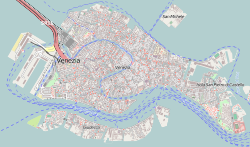| Sant'Alvise | |
|---|---|
 Sant'Alvise in Venice | |
| Religion | |
| Affiliation | Roman Catholic |
| Province | Venice |
| Location | |
| Location | Venice, Italy |
| Coordinates | 45°26′51″N12°19′45″E / 45.4475°N 12.3292°E |
| Architecture | |
| Completed | 1338 |
Sant'Alvise is a church in the sestiere of Cannaregio in Venice, northern Italy. The brick exterior and facade do not reflect the rich interior.











